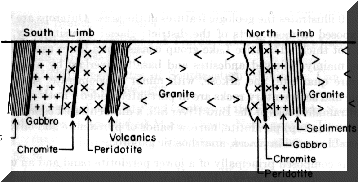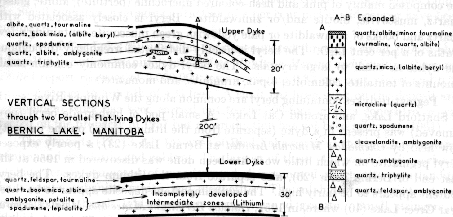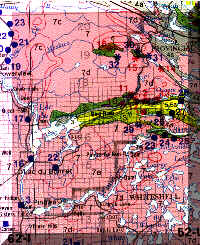Mining in Manitoba
Geology of the Bernic Lake Area
GEOLOGY
|
|
The Bernic Lake area has widespread and well exposed outcrops and glacial deposits (clay, sand, and gravel). The Rice Lake group consists of a lower assemblage of volcanic rocks, mainly pillowed andesites and basalts, overlain by a series of greywacke, impure quartzite and arkose, with minor conglomerate, slate and chert. The volcanic and sedimentary rocks are interbedded. Both are intruded by mafic and ultramafic rocks of the Bird River Sill, a differentiated complex composed of peridotite, narrow bands of pyroxenite and olivene gabbro, hornblende gabbro, and in places, anorthositic gabbro. |
The volcanic, sedimentary, and mafic intrusive rocks have all been invaded by granitic intrusions ranging in composition from quartz diorite to granite and pegmatite. Most of the granitic rocks occur as large bodies enclosing the volcanic-sedimentary belts. Large bodies of granite lie not far below the surface. Grade of metamorphism also increases eastward; the rocks in the eastern part of the area have been recrystallized to quartz-feldspar-mica schists and hornblende-plagioclase schists.
Several cross-faults displace the volcanic and sedimentary rocks, the Bord River Sill, and granitic rocks. The horizontal displacement along some of these is more than a mile.
MINERAL DEPOSITS
a) Chromite
Chromite occurs as stratiform deposits within the lower periodotite of the Bird River Sill. Bands of dense and disseminated chromite are separated by layers of periodotite containing variable but small amounts of chromite.

A large number of closely spaced transverse faults cut the chromite zones up into short blocks.
b) Lithium and Beryllium
Pegmatite dykes containing lithium and beryllium minerals occur in volcanic and granitic rocks close to the margins of the large granitic intrusions. Most of the lithium dykes are in volcanic rocks. Many beryllium pegmatites occur within the granite.
The horizontal dykes generally are zoned, although not always no both sides. The result of the zoning is that the various valuable silicate minerals are concentrated in different bands or lenses. The main lithium minerals found in the flat dykes are spodumene, amblygonite, petalite, lepidolite, and triphylite. All lithium minerals occur in core zones and closely associated with quartz.

The deposit on Bernic Lake contains lenses of pollucite as well as lithium minerals.
